Late the next morning we arrived in Thunder Bay, Ontario. The area was an important center for fur trading beginning in the 17th century. The French were the first Europeans to engage in the area at the mouth of the Kaministiquia River, but France lost their North American territories after the Seven Years War and abandoned the area in the 1760s. When the English began to exploit the fur trade, they set up their primary trading post at Grand Portage about 40 miles to the southwest. After the American Revolution, the British abandoned Grand Portage, now located in the United States, and founded a new trading post that became Fort William in what is now Thunder Bay.

We received a rousing welcome into Thunder Bay by the MacGillivray Pipe Band. They played a special strathspey for me when I introduced myself as a Scottish fiddler (I just happened to be wearing my Strathgheny sweatshirt).
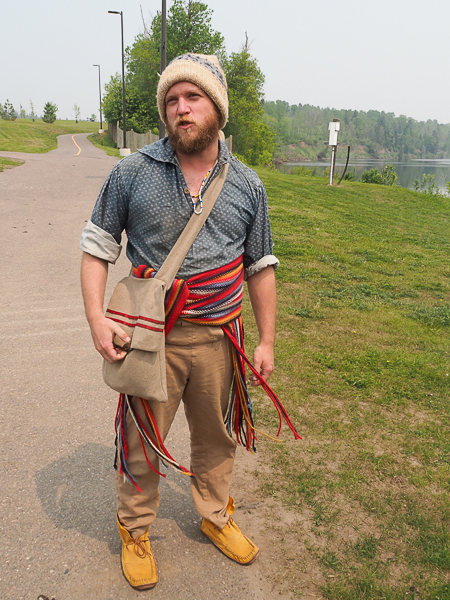
The afternoon's expedition was to Fort William Historical Park. We were met by "Ignace," wearing the traditional garb of a voyageur. He and others guided us to the fort and other displays in a birchbark canoe similar to those used by the French-Canadian voyageurs during the early 19th century. The canoe was much larger than the ones I paddled when getting my Girl Scout canoeing badge! It held about twelve people including the four re-enactors. Yes, we had to paddle, but I am grateful that we didn't have to maintain the typical voyageur rate of one stroke per minute!
In true voyageur tradition, Ignace taught us to sing to coordinate our strokes. He sang the verses (in French, of course) and we chimed in on the refrain of: "Oui, oui, oui; non, non, non." I have no idea what we were either agreeing to or protesting, but it was great fun.
We received additional instruction in proper protocol for identifying ourselves to the folks at the fort as we arrived.
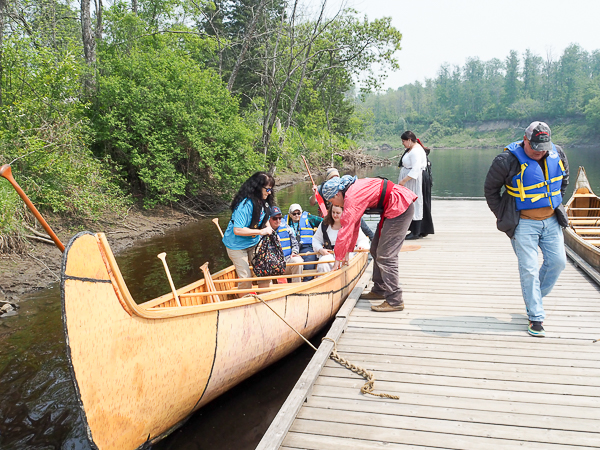
We have arrived after our short trip down the river.
The voyageurs used even larger vessels called Montreal Canoes to haul tons of trade goods to the west to trade for tons of furs to take back to Montreal. There was little room for cargo in this one once all the paddlers got in.
I am no longer as graceful getting into and out of a canoe as I once was, but no one got dunked.
Elsewhere at the fort we were able to see the process of making birchbark canoes.
Once we had all clambered out of the canoe, we met our new guide "Jean Baptiste le Gros." As it happened, he was far from "gros," which means "fat" in French.

Our first site was a recreated encampment of First Nations traders. The local people were Anishinaabe, but many groups traveled to the Rendezvous. We had already heard much about the Ojibwe on our travels and they were a subset of this nation.
This display of pelts that would have been traded here includes fox, wolf, mink, ermine, otter, and most desired, beaver (the round pelt).

This is a small adjacent birchbark smokehouse. The residential wigwam was similar, but much larger -- too large and too surrounded by trees to get a good picture.
The birchbark is stitched together and layered. It was not, however, sealed as it is for a canoe because ventilation was essential.
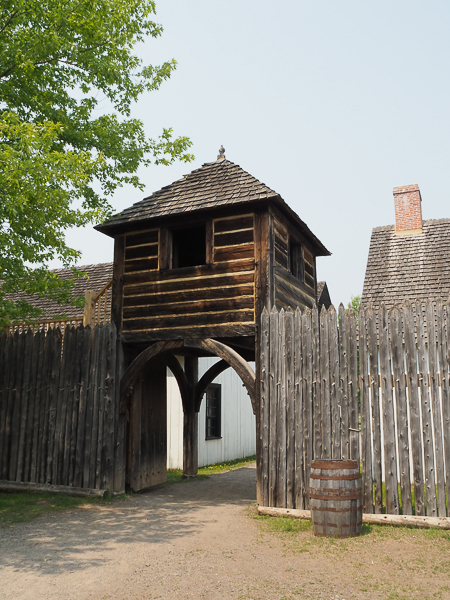
The original location of Fort William at the mouth of the Kaministiquia River is now part of the city of Thunder Bay. This reproduction is located farther upstream and based on historical descriptions.
The palisades were not intended for protection against the Native peoples, who were there to trade rather than fight, but against wild animals.
(One of the bulk carriers that we saw pass the Soo locks was named the Kaministiquia. See her checkered history. It was pretty common for all the ships I identified to have complicated if not colorful pasts.)
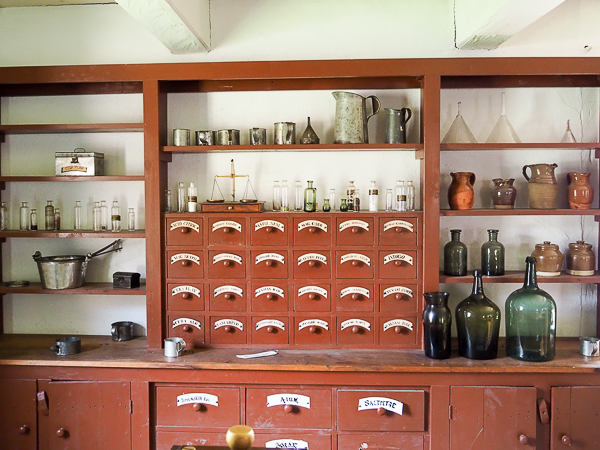
A resident physician maintained an extensive apothecary's shop. Many of the traders who came for the rendezvous would only be able to get European medical treatment while here. Otherwise they relied on Native medicine (which may have been as good or even better).
The park features a major re-enactment of the Great Rendezvous in July. It would be worth going just to see all the canoes coming in.
A local news video provides more information about the annual celebration.

Housewares were available for purchase with money received for furs.
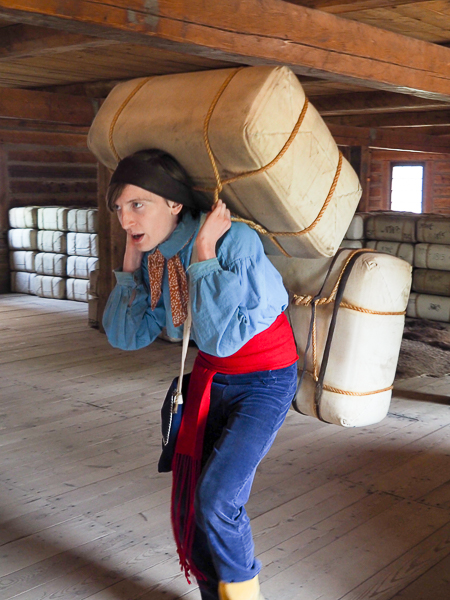
Our guide demonstrated the way voyageurs carried fur packs over the portages. A stamping device compresses about 90 pounds of furs into a compact shape, which is then sewn into these standard packs. The Montreal canoes could carry up around four tons of cargo. Some of that was food and supplies, but all of it needed to be loaded at the fort, unloaded at the beginning of each portage, and reloaded at the end of the portage. The canoe itself weighed about 1500 pounds and needed several men to carry it over a portage.
A common affliction of voyageurs was hernia.
Small wonder that the first lock at the Sault Stainte Marie falls was canoe-sized and greatly welcomed. Unfortunately for the voyageurs, it was destroyed during the War of 1812 and not replaced until 1855 after the heyday of the Fort William rendezvous. The next major portage was around Niagara Falls until the Welland canal opened in 1829, also after Fort William had fallen out of use.

The large building is where the higher-ups met and dined during the rendezvous. Common voyageurs made do with campsites.

It is hard to see the scale of this Montreal canoe in the boat house, but it is clear that it is much larger than the adjacent canoes, which were comparable to the one we arrived in.
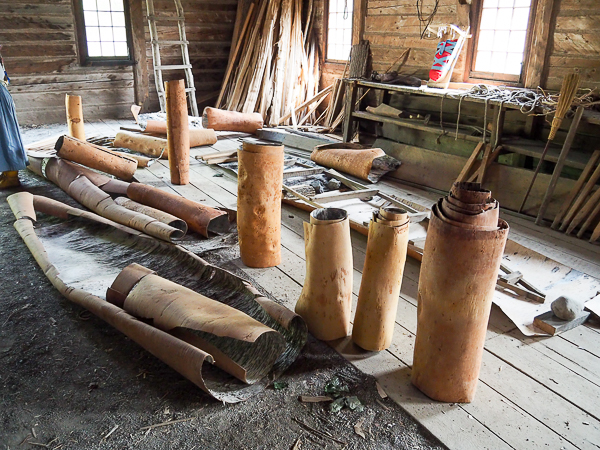
Volunteers and staff were in the process of preparing a new canoe. Or at least they had the materials laid out for it. The Marquette page had a link to a discussion of how canoes were constructed.
That evening we began our two nights and a day cruise across Lake Superior to the Soo Locks. It is still hard to believe how large the Great Lakes really are.
Click your "back" button to return to the previous page or click for our picture album.